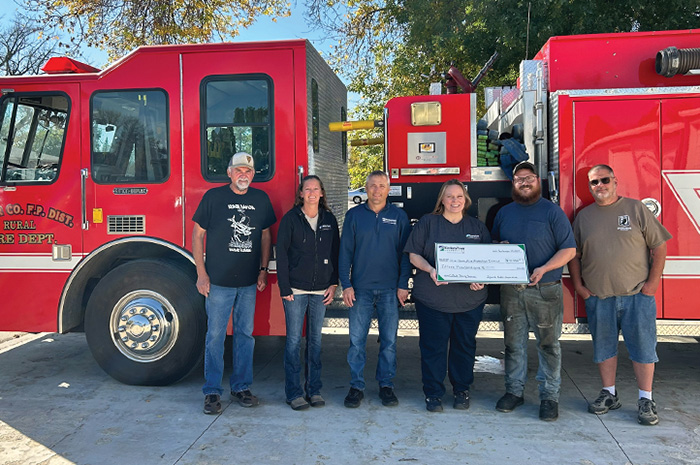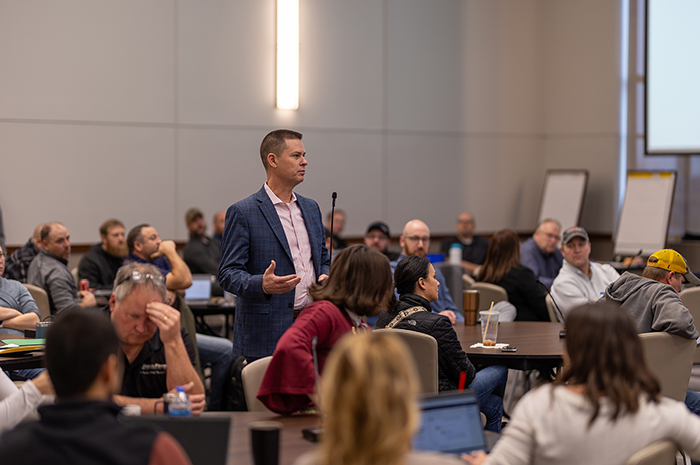‘Critical’ opportunity for North Dakota
Minnkota Power Cooperative is joining industry research partners in capitalizing on rare earth elements.
From where Ian Feole stood on Sept. 18, he could see a 9-million-pound coal dragline scooping earth just beyond the adjacent field. Looking farther, the familiar 550-foot stacks of Minnkota’s Milton R. Young Station power plant rose on the horizon. Everything in this area south of Center, N.D., was huge, unmissable.
But Feole was digging for something so small, it would be imperceptible to his human eye.
“The goal is to find enough rare earth elements across the state to make a viable industry,” the geologic engineer explained as a crew drilled for a coal-seam core sample 120 feet below the surface.

Feole and his team at the Energy & Environmental Research Center (EERC) in Grand Forks, N.D., are among many North Dakota entities taking a deep dive into the promise of critical minerals and, more specifically, rare earth elements (REEs). Researchers at the EERC are focused on determining the concentration of critical minerals in North Dakota’s lignite coal. At the same time, the University of North Dakota College of Engineering and Mines Research Institute (CEMRI) is developing the technology needed to extract and process REEs for the commercial uses that harness their unique properties.
“Those properties make them truly irreplaceable in an incredible variety of consumer products and applications – things like your smartphones and computer drives, but also military systems and energy systems,” CEMRI Executive Director Dan Laudal said of REEs. “The challenge is that our domestic supply chains right now are heavily reliant on foreign countries to be able to supply our needs. The federal government recognizes this as a risk, so they’ve been aggressively ramping up research and development funding, over the past several years, to help address it.”
CEMRI and its research partners at the EERC are both recipients of a portion of this federal funding. Minnkota Power Cooperative is a proud industry sponsor of both endeavors, including a partnership in CEMRI’s latest phase of REE research. In April 2023, CEMRI was awarded $8 million through the Bipartisan Infrastructure Law to pursue Front-End Engineering Design (FEED) studies for a commercial REE plant. These plans are based on a process technology CEMRI has been scaling up over many years, evolving into a pilot-scale facility.

CEMRI and West Virginia University are competing to enter the next phase of this research. If selected, CEMRI could be the recipient of $125 million in additional federal funding to build and operate an REE plant in North Dakota, potentially located next to Minnkota’s Young Station.
“It’s a truly exciting opportunity and I’m thrilled to be a part of it,” Laudal said.
In our backyard
Rare earth elements are a set of 17 metallic elements that can be found near the bottom of the periodic table. Some of these 17 have properties that make them “special” in manufacturing technology – they are luminescent, electrically conductive or magnetic in ways that support digital magic. They’re not as rare as the name implies, but ways to feasibly mine and process them are. Through diligent core sampling like that done by Feole in September, EERC has found that North Dakota’s coal seams contain extractable quantities of REEs.

John Kay, the project lead of EERC’s Williston Basin Carbon Ore, Rare Earth, and Critical Minerals (CORE-CM) initiative, says an REE concentration of more than 300 parts per million (PPM) enters the suitable range for national interest. In the Williston Basin, they are finding many areas in the 600 PPM range, with certain spots exceeding 1,000 PPM. “It looks very promising. The Williston Basin is a good location to think about this kind of extraction,” Kay said.
The region has an additional advantage. As the home of several established coal mining and power generation operations (such as Minnkota and its partner BNI Coal), mining permits and infrastructure challenges are already overcome. REEs are often found the in top and bottom few inches of the coal seam that is already being mined for energy. With one additional process in the middle, REEs could be extracted, creating an entirely new industry.
“Other areas and regions aren’t as fortunate,” Kay said. “Ours is a very flourishing industry that’s already going. We just get to jump in and kind of elbow our way in and say, ‘Is there room for us?’ And of course, everyone says, ‘Sure, come on in.”
Value added to the region
North Dakota isn’t alone in its search for critical minerals and REEs. The race is on in many states to find extraction and commercialization methods. There are several reasons, but two rise above: supply chain security and economic opportunity. Right now, upwards of 85% of the world’s REEs come from China, and, anecdotally, it’s never a good idea to have all of your eggs in one basket.
“We’re always going to have to rely on imports,” Kay said. “But what this does is, if an outside source decides they economically want to influence something and they start controlling what they’re able to provide, the hope is that our domestic capabilities level out those hills and valleys, and that we have something else we can rely on.”

By extension, a new domestic industry providing the U.S. economic protection would also foster economic development in communities home to REE extraction and processing. New industries bring in new companies, new companies bring in new workers, and workers bring in their families. The number of stores, restaurants and services expands with population, creating a cycle of community growth.
An emerging REE industry in western North Dakota would also strengthen its hallmark energy production industry. As REEs are extracted, coal is stripped of much of its sodium content, allowing it to burn cleaner in electric generation. The industries would become mutually beneficial, each bolstering the other.
“If this develops here, it means the Young Station has checked the box again on why it’s a valuable facility,” said Craig Bleth, Minnkota Vice President of Project Development. “It would be good for the future of the plant, as well as all of the employees who have built a life in this industry, in this state.”
Although North Dakota’s REE leadership will serve the nation as a whole, Minnkota is honored to leverage innovation to support a key cooperative principle closer to home – concern for community.
“What a better thing for the state as a whole? We want to grow, and this is a way to grow. This is a way to keep our local people in the state. It’s all good,” Kay said. “It helps us maintain what we’re doing, and at the same time, make it a little better.”
MAIN IMAGE: EERC geologic engineer Ian Feole and BNI Coal geologist/hydrologist Derrick Placek measure and package a core sample near Center, N.D. (Minnkota/John Kary)
...



